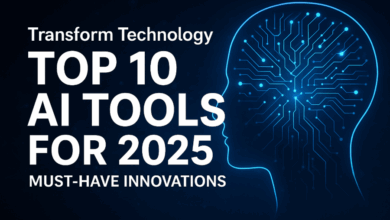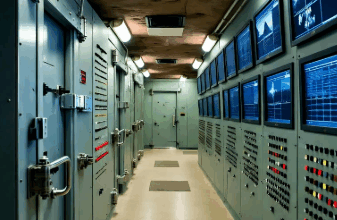AI Productivity in 2025: Smarter Tools, Better Work
AI Productivity Revolution: How Next-Gen Tools Are Redefining Work in 2025
The Smartest Workforce Yet
Artificial Intelligence has entered a new phase — it’s not just about automation anymore.
In 2025, AI is transforming from a background assistant into an active collaborator. Whether it’s writing code, designing visuals, or managing complex data workflows, AI tools are reshaping how humans approach work.
The AI productivity revolution is not replacing people — it’s redefining what human productivity means in the digital era.
1. Understanding the AI Productivity Revolution
Artificial Intelligence in 2025 is all about autonomy, adaptability, and accuracy.
Next-generation AI tools combine natural language understanding, predictive analytics, and generative capabilities to perform high-level cognitive tasks — not just routine automation.
- They can learn from user habits to personalize workflows.
- They can generate content tailored to tone and context.
- They can make predictions that support faster, data-driven decisions.
This shift has made AI a strategic partner across industries rather than a simple utility.
2. Top AI Productivity Tools Leading 2025
The tools defining this revolution blend creativity with automation. Here are the ones shaping daily work in 2025:
🔹 ChatGPT Team & Enterprise
AI-driven collaboration hubs that write, analyze, summarize, and ideate within company data. They turn brainstorming into execution.
🔹 Microsoft Copilot
Deeply integrated into Office 365, it helps users analyze data, draft reports, and prepare presentations — reducing workload hours significantly.
🔹 Notion AI & ClickUp Brain
Knowledge management meets intelligence. These apps summarize meetings, generate task lists, and automate project planning.
🔹 Fireflies AI
A digital meeting assistant that transcribes and highlights key decisions automatically, making post-meeting chaos a thing of the past.
🔹 Tome AI & Canva Magic Studio
Design-oriented AI that generates visual assets, slides, and marketing creatives in seconds — merging aesthetics with automation.
Each of these tools symbolizes how AI has become part of the professional toolkit, not a futuristic add-on.
3. The Human + AI Synergy: Collaboration, Not Competition

AI doesn’t aim to replace human intelligence — it enhances it.
The 2025 workplace is a hybrid ecosystem where human creativity and AI precision coexist.
| Humans | AI |
| Creative thinking | Pattern recognition |
| Emotional intelligence | Data processing |
| Strategic vision | Speed and accuracy |
Together, this partnership amplifies efficiency while preserving human innovation.
Examples include:
- Marketers using AI analytics to focus on storytelling.
- Developers leveraging AI to debug and test faster.
- Teachers employing AI tutors to customize learning experiences.
This new model of “augmented intelligence” ensures people stay at the center of progress.
4. Industries Redefined by AI Productivity
A. Marketing & Content Creation
Generative AI tools like Jasper, Copy.ai, and ChatGPT enable content teams to create SEO-optimized blogs, campaigns, and ads in minutes — personalized by audience intent.
B. Software Development
GitHub Copilot and CodeWhisperer reduce debugging time by nearly 40%, enabling developers to focus on architecture and innovation.
C. Education
Adaptive learning platforms powered by AI, such as Khanmigo and Duolingo Max, create custom learning paths for each student.
D. Customer Support
AI chatbots handle up to 70% of requests instantly, giving human agents the bandwidth to manage complex emotional interactions.
E. Business Management
Automation platforms like Zapier AI and UiPath streamline repetitive office work, minimizing human error and freeing creative capacity.
5. The Productivity Paradox: Too Many Tools, Too Little Focus
The rise of AI tools brings immense efficiency — but also distraction.
Companies adopting dozens of apps face tool fatigue and reduced concentration.
This is known as the Productivity Paradox — where the pursuit of efficiency actually lowers it.
How to overcome it:
- Use fewer, integrated AI platforms instead of scattered ones.
- Define clear AI usage policies to avoid redundancy.
- Encourage “deep work” culture even in automated settings.
In 2025, mastering productivity means balancing automation with attention.
6. Data Privacy and Ethical AI Use

With great power comes great responsibility — especially when AI handles sensitive business data.
The global rise of privacy regulations like the EU AI Act and GDPR 2.0 updates in 2025 has pushed companies to prioritize transparency.
Key ethical challenges include:
- Data Ownership: Who owns AI-generated insights?
- Bias Control: Ensuring fairness and diversity in training data.
- Security: Protecting cloud-based AI environments from breaches.
Smart businesses now maintain AI Governance Frameworks — internal systems that ensure each AI tool complies with ethics, privacy, and sustainability goals.
7. Preparing for the AI-Driven Future
Organizations embracing the AI productivity revolution must prepare both technologically and culturally.
🔸 Step 1: Adopt AI with Purpose
Don’t integrate every shiny tool. Choose AI that genuinely supports your mission and workflow.
🔸 Step 2: Upskill the Workforce
AI literacy and prompt-engineering training are vital. Employees must learn how to think and communicate with AI effectively.
🔸 Step 3: Measure Value, Not Speed
True productivity isn’t how fast you work — it’s how much value your work creates.
🔸 Step 4: Build Ethical AI Policies
Set transparent rules for data use, disclosure, and employee oversight.
🔸 Step 5: Encourage Human-AI Co-Creation
Promote a culture where humans refine AI outputs, creating a continuous improvement loop.
8. The Future Outlook: From Automation to Empowerment
The next phase of AI isn’t about doing more — it’s about doing better.
By 2030, analysts predict that AI will contribute $15.7 trillion to the global economy (PwC report).
But the real revolution is not economic — it’s human.
AI allows us to:
- Focus on strategic and creative work.
- Eliminate repetitive stress.
- Achieve work-life balance without sacrificing innovation.
In short, AI doesn’t replace jobs — it redefines them.
Redefining Productivity in the Age of AI
The 2025 AI productivity revolution is a milestone in human evolution — where intelligence, creativity, and technology finally merge.
Companies that adapt will not only become more efficient but also more human.
The question is no longer “Will AI change work?” — it already has.
The real challenge now is:
How will we use AI to build a smarter, calmer, and more meaningful way to work?




